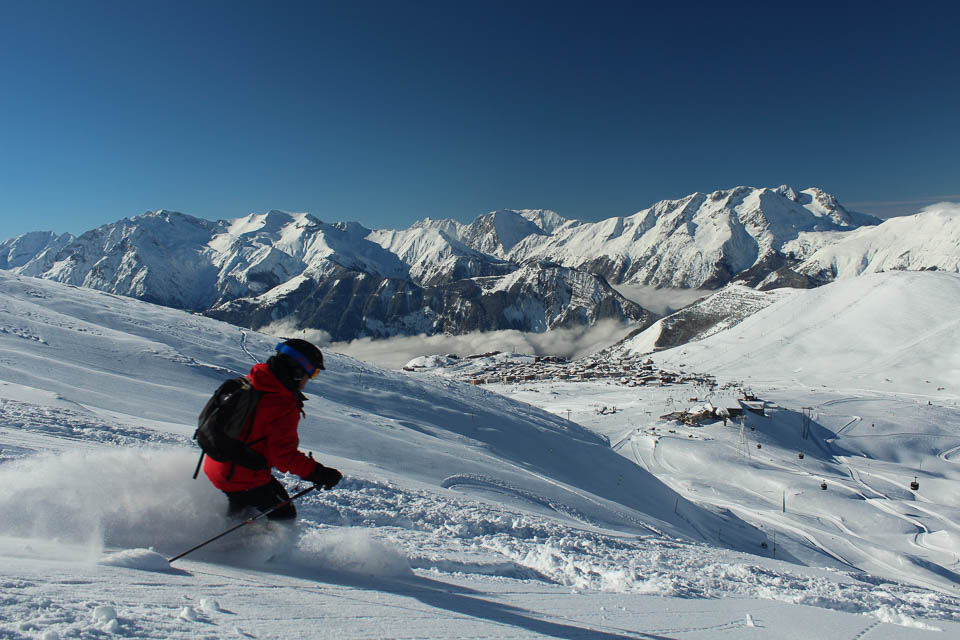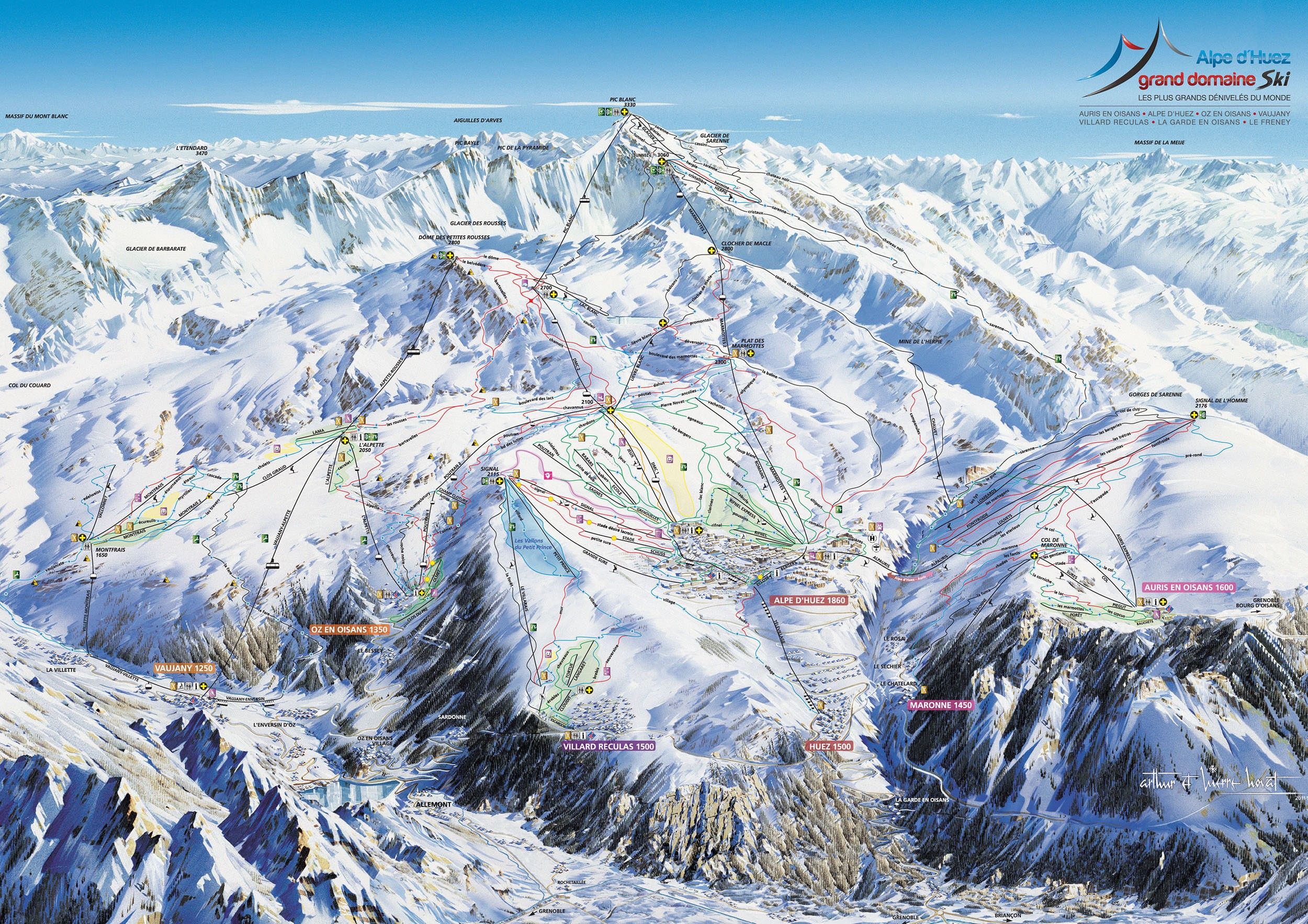Alpe d'Huez - slopes
---crop960.jpg)
The slopes are divided into four sectors, interconnected by lift, with the biggest, Pic Blanc, directly above Alpe d’Huez. The impressive two-stage Grandes Rousses telecabine (a.k.a. the DMC lift) rises from the base village to Lac Blanc (2,700m), before a connecting cable car ascends to 3,330m Pic Blanc, overlooking the Sarenne Glacier.
From here, the alleged ‘longest groomed run’ in the Alps begins, the 16-kilometre Sarenne. While a number may now claim that title, Sarenne is certainly the longest black in the Alps (although it does flatten out at the bottom). The Sarenne Glacier can also be reached via the Marmottes chairlift and two-stage Marmottes telecabine. At Pic Blanc, as an alternative to the Sarenne, you can go through a 300m-long tunnel to access a steep mogul field.
 Photo: Daniel Elkan
Photo: Daniel Elkan
On the opposing mountain side is the lovely Signal de l’Homme area, accessed by the Alpauris chairlift from the Alpe d’Huez’s Les Bergers district. The lift takes you down into a gorge before rising to the slopes. Here, a network of blues and reds take you down to L’Auris or Le Chatelard, or back down towards the gorge.
The small and mostly gentle sector of Signal is the most accessible from the village and popular with second-week beginners and improving intermediates. There are also some easy runs, as well as one black, on the sector’s far side leading down to the old village of Villard Reculas. Signal has a run that is floodlit on two evenings a week.
The resort’s fourth sector is Vaujany-Oz, which has its slopeside hub at Alpette (2,050m) on the opposite side of the ridge above Alpe d’Huez. A large, two-stage cable car rises from Vaujany to Dôme des Rousses (2,800m), where you’ll find several satisfyingly long reds. Intermediates can enjoy the network of blues and reds at Montfrais (1,650m), reached via telecabine from Vaujany.
 - crop960.jpg) Photo: Laurent Salino
Photo: Laurent Salino
Ski highlights for all levels
Beginners: Directly above the village there is an expansive network of beginners’ slopes. Such a big area of nursery runs means that newcomers can stretch themselves without having to worry about going too high up the mountain.
There’s also a good selection of green runs at Les Bergers, served by the Romains chairlift.
Both areas are dedicated slow zones, although some skiers tend to ignore this. Overall, there are few resorts where novices are better catered for than Alpe d’Huez.
Intermediates:
Most holiday skiers fall into the intermediate bracket, and so most will love it here! Alpe d’Huez is simply fabulous for intermediates– especially for those with a little adventure in their soul. There are runs all over the mountain that will test them without being scary. It’s the red run capital of the French Alps – with plenty of super blues too.
Another big plus is that many of the runs at Alpe d’Huez are extra long – lots of turns are exactly what an intermediate needs to progress, and this is the place to find them. The Signal de l’Homme area has some long and usually quiet reds, giving you plenty of elbow room to work on technique.
The runs from Signal (2,100m) down to Villard-Reculas will stretch intermediates too, putting thighs through their paces. Even the long black Sarenne run from Pic Blanc can be tackled by a fit upper intermediate, as long as care is taken on the steep, moguled upper section.
For the more timid intermediate, there are lots of blues to practise on, particularly in the Signal sector and at Montfrais. And there are some off-piste runs, to be taken with a guide, that are perfect for intermediates making their first forays away from the groom.
 - crop960.jpg) Photo: Lionel Royet
Photo: Lionel Royet
Experts: Experts won’t be bored here! A first glance at the piste map might show a predominance of reds, but there are some challenging blacks from most top stations at Alpe d’Huez, and some testing reds that would be categorised black in many other resorts. There’s a huge array of off-piste for advanced skiers and boarders, for which you should take a guide.
If you’re sticking to the piste, the Tunnel run from Pic Blanc is interesting: first a steep mogul field, then the 300m long tunnel from which you emerge blinking into the sun to find an even steeper mogul field – which can be hard and icy in the mornings. A nice way to wake up!
The Marmottes II telecabine gives access to two decent blacks: Balcons, which is quite steep but usually with good snow and rarely too crowded, and the less-testing Clocher de Macle.
Signal de l’Homme is particularly handy if you have a mixed group because there is a good choice of runs of varying difficulty which conveniently meet lower down.
Off-piste (always with a guide), the most popular routes include the Combe du Loupe – at the top often described as a steeper version of the Swiss Wall at Avoriaz – in a sunny bowl which ends in a gentle run out. The Grand Sablat is wild, beautiful and tough in places, initially over the glacier with some steep couloirs. After a total vertical of about 2,000m, you’ll arrive at the village of Clavans, from where you can take a taxi back to Alpe d’Huez. Another 2,000m descent is available from Col de la Pyramide (which involves a 50-minute hike from the top of Pic Blanc). This off-piste route takes you to the runs above Vaujany. There are many other options – some that can be tackled by decent intermediates as well as experts. A visit to one of the ski schools to discuss conditions and hire a guide is essential to get the most from your holiday.
Ski schools and guides
Alpe d’Huez has four ski schools – ESF, EasySki, Stance and Masterclass. All, including ESF, have teachers fluent in English and good reputations. For non-English speakers, ESF claim to have instructors who can accommodate Italian, Dutch, Spanish, Japanese, Danish, German, Portuguese, Russian, Polish, and Hebrew –impressive! Stance are very flexible, with group or one-to-one lessons available from two hours to six days or more. Masterclass is a British school run by BASI trainer Stuart Adamson, who has been in the resort for nearly 20 years, holds the French Equivalence, and specialises in providing intensive teaching for British clients by British-trained instructors.
Terrain park
The resort has an impressive, extensive park for expert freestylers right beside the DMC 1st station, with a half-pipe, jumps, rails and a boardercross course. There’s also a gentler park for aspiring freestylers to have a go at the foot of the slopes.
Snow reliability and snowmaking
Many of the slopes in Alpe d’Huez are high, with skiing taking place from 3,330m (10,920ft) down to 1,100m (3,610ft). The good snow that results from this altitude tends to offset the fact that the long days of sun can adversely affect conditions on the resort’s predominantly south-facing slopes. Local topography also helps to conserve good snow, with high ridges and peaks keeping many of the runs, particularly those above Vaujany, in the shade for much of the day.
The slopes from Signal de l’Homme also seem to keep snow in good condition. Suffice it to say that Alpe d’Huez hasn’t built up its fine reputation by letting people down, and we at Snowcarbon have always enjoyed excellent skiing on decent snow on our visits. It’s such a big domain that it pays each morning to check conditions from sector to sector so you can steal a march and set off early to hit the slopes with the best snow. There's extensive snowmaking on all the principal runs above Alpe-d’Huez, Oz, and Vaujany.

| Village altitude | 1860m |
| Ski altitude | 1125–3330m |
| Ski area | 250km |
| Blue runs | 37 |
| Red runs | 39 |
| Black runs | 17 |
| Total runs | 135 |
| Snowparks | 3 |
| Chair lifts | 23 |
| Drag lifts | 30 |
| 6-day ski pass | TBC |
| 1-day ski pass | TBC |

